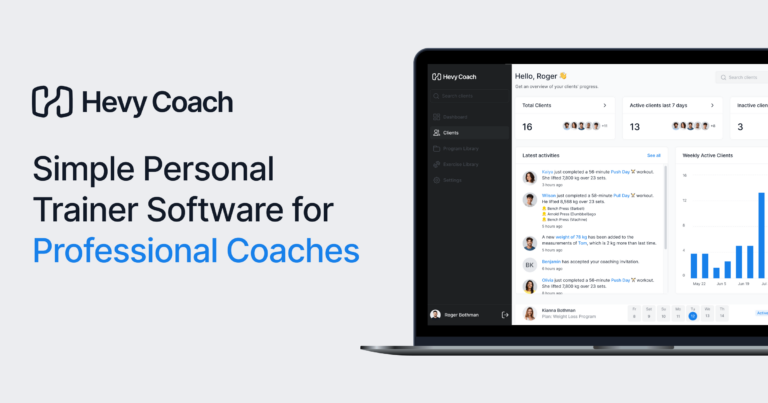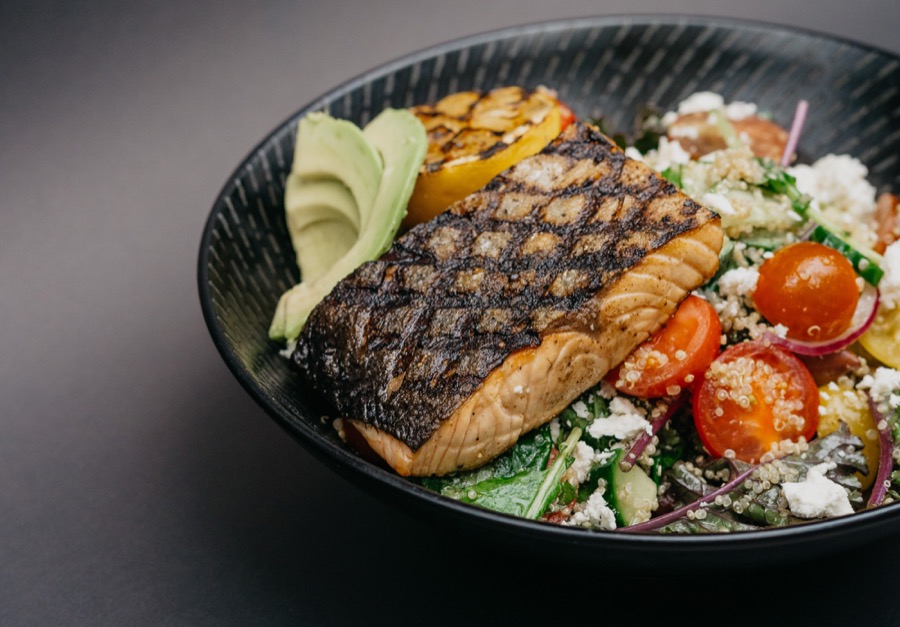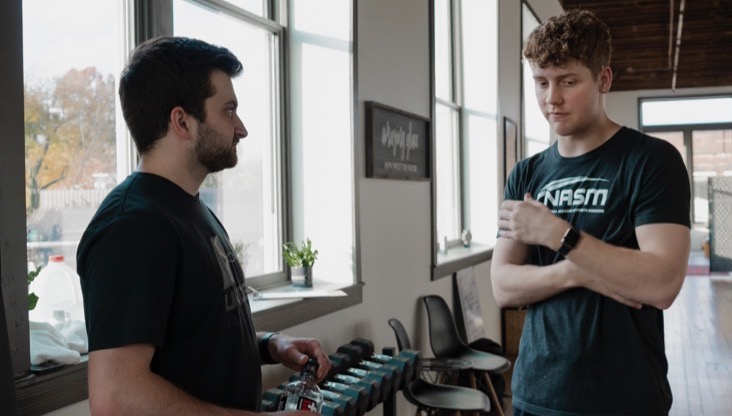Getting to know new personal training clients is a big part of the job, and there is no better way to get started than with a questionnaire form.
If you’re unsure what that means or want to know what questions to ask prospective clients, stick around because we are breaking it all down for you today.
Let’s discuss.
The Importance of Personal Trainer Questionnaires
A personal training client questionnaire form is beneficial for a few reasons:
1. Determine If You Would be a Good Fit
The first and most important reason for conducting an interview and asking prospective clients a bunch of health, fitness, lifestyle, and medical questions is to immediately tell if you can help them.
For example, if someone says they are dealing with multiple recurring injuries and you’re not qualified to help, you can immediately refer them to a specialist and save both of you time.
2. Understand Their Goals
A personal training questionnaire is an effective method for getting to know prospective clients and learning what short and long-term goals they want to achieve.

If you ask the right questions, you can also gain insight into what motivates them to get fit now, which could help you serve them better.
3. Assess the Client’s Abilities
The next reason for using a personal training questionnaire is to learn about your prospective client’s abilities and limitations.
Having that information is necessary for developing the most effective training plan that helps them reach their goals without putting them at risk of injuries.

Try Hevy Coach
Intuitive personal trainer software, with a world class experience for your clients.
30 day free trial, no credit card required
4. Learn About Potential Limitations
Asking the right questions helps you learn about your prospective client’s limitations––previous or current injuries, health conditions, etc.
That information allows you to determine if you would be a good fit to work together and how to coach them effectively.
Sometimes, you won’t be able to help a prospective client because their issues would be outside your area of expertise.
5. Build Rapport
Aside from getting as much information as possible about a client, an initial consultation provides an excellent opportunity to build rapport and show that you care.
Asking the right questions and listening to what the person has to say shows your professionalism, puts that person at ease, and builds trust.
After all, who appears to care more about their clients:
a) A trainer who barely asks questions before handing a workout program to a client.
b) Someone who conducts a 45-minute interview, listens carefully, and provides a tailored training program with helpful guidance, nutritional tips, and suggestions for a healthier lifestyle.
Check out Hevy Coach if you’re looking for an all-in-one platform that allows you to manage your clients easily. Write and deliver training programs, make adjustments when necessary, communicate with clients, track their progress, and more––all from a single dashboard. Test the platform for free with one client.
Personal Trainer Questionnaire for Clients: What You Should Ask
The following sections will cover some of the most common questions you should ask new clients. I recommend starting with medical questions to see if you would be able to help that person.
Medical Questions/PAR-Q
PAR-Q, also known as Physical Activity Readiness Questionnaire, is a 7-step questionnaire that helps professionals assess a person’s ability to safely engage in exercise.
Below are the seven PAR-Q questions:
- Do you have a diagnosed heart condition, and has a doctor ever said you should only follow an exercise program approved by a doctor?
- Do you experience chest pain during exercise?
- Have you had any chest pain while at rest in the last month?
- Do you ever get dizzy and lose your balance? Have you ever lost consciousness as a result?
- Do you have bone or joint problems that get worse with exercise?
- If you have cardiovascular issues, does your doctor currently prescribe any medications?
- Can you think of other reasons why you might not be able to exercise?
Here are a few additional questions you can ask:

- Have you ever suffered an injury in the past? If so, what kind and how severe was it?
- Are you currently recovering from an injury or trauma?
- Have you ever been to a physical therapist? If so, why?
- Do you currently take any medications? If so, what kind and what dosages?
- Have you undergone surgery in the last year?
- Have you been hospitalized in the past? If so, why?
- Do you have any other conditions that could affect your ability to exercise?
- Are you pregnant, or have you given birth in the last 12-18 months?
- Have you undergone any other therapies?
- Do you have any known allergies or food sensitivities?
Fitness and Health Questions
The following section is far more fitness-specific. You can get creative here and ask all the questions that interest you as a personal trainer. Here are some to consider:
- How many times a week can you exercise?
- How much time can you dedicate to each workout?
- Do you have a preferred exercise type––cardio, strength training, yoga, etc.?
- Do you have any specific dislikes––for example, you hate treadmill running?
- Do you prefer to use specific exercise equipment––for example, gym machines over barbells?
- Have you done sports in the past? If so, what type and at what level?
- Have you followed a structured exercise program in the past? If so, for how long, and what were the results?
- Have you worked with a personal trainer in the past? If so, what did you hope to achieve, and were you successful?
- What successes have you had with previous fitness training?
- What failures and roadblocks did you experience when exercising in the past?
- Do you currently engage in any physical activity outside the gym? If so, can you describe it briefly?
- Why do you want to work with a personal trainer now?
- What expectations do you have from your coach or PT?
- On that note, why do you want to pursue fitness now? Briefly describe your motivations.
- How often would you like to communicate––daily or only at the gym?
- What is your preferred coaching style? Hands-on, laid back, motivational, tough love, etc.?
- What would you say are some things keeping you from working out?
- What roadblocks are you experiencing––unpredictable work schedule, binge eating behaviors, etc.?
- What short and long-term fitness goals do you have?
- What is your preferred workout environment––at home, the gym, or outdoors?
Lifestyle Questions
Finally, we arrive at the last section, where we learn more about our prospective client’s lifestyle and how a typical day goes for them. Here are some questions to ask:

- What do you do for a living?
- What is your daily routine like? Can you briefly describe a typical day?
- How stressed would you say you are on a scale from 1 to 10?
- How long do you sleep at night on average?
- What are your sleep habits like?
- Would you say you’re sleeping well and feeling rested upon waking?
- What is your nutrition like? Can you briefly describe a full day of eating?
- Do you have any experience tracking calories and macronutrients?
- Have you been on restrictive diets in the past?
- Do you have any food allergies or intolerances?
- How much water do you drink in a day? Can you briefly describe your hydration habits?
- Do you smoke or drink alcohol? If so, how often?
- Do your habits look significantly different over the weekend versus weekdays?
Related Article: Personal Trainer Consultation Form: What It Is and Why You Need It
5 Tips for Conducting Productive Consultations
1. Find a Comfortable and Private Spot to Chat Uninterrupted
You can give a copy of your personal training client questionnaire to people who want to work with you and tell them to fill it out on their own time and return it within a few days.
That approach can work, but a more personalized option is to actually schedule a session with them for up to 45 minutes and go through the questions together. To do that, find a comfortable and private spot to chat where you won’t be interrupted. For example, read each question and write down the person’s responses yourself.
The more at ease your prospective client feels, the more likely they will be to open up.
2. Start off Easy
Don’t immediately jump into the questionnaire. Instead, greet your prospective client and chat for a few minutes. You can even share some information about yourself to put the person at ease.
Building rapport first can help you get more valuable responses that reveal more about the person.

Try Hevy Coach
Intuitive personal trainer software, with a world class experience for your clients.
30 day free trial, no credit card required
3. Write Down Personal Information
Start each questionnaire by filling out some basic information about the prospective––for example, their name, age, gender, and contact details.
Doing so is necessary for keeping your documents organized.
4. Set the Right Expectations
As you start filling out the questionnaire and the person (hopefully) opens up about their goals and aspirations, be encouraging and set the right expectations. It can be tempting to promise them the world, but that often leads to disappointment down the road.
Discuss the person’s short and long-term goals and provide realistic timelines for achieving them.

5. Leverage the Power of Follow Up Questions
Filling up the personal training questionnaire should be your top priority but don’t be afraid to improvise a bit. After all, you’re sitting down with a person and conversing.
Ask the questions you’ve written down but also feel free to follow up on some inquiries if you need more information.
Related articles: Workout Templates for Personal Trainers: Why You Should Use Them (+Free Examples)
Final Words
A personal training questionnaire is extremely important because you get to know prospective clients. As a result, you can determine if you would be a good fit together.
Moreover, a questionnaire can help you build rapport and get people to open up and talk about their goals and aspirations, which can motivate them.
To get the most out of a questionnaire, find a comfortable spot to chat, start with some small talk, set the right expectations, and don’t be afraid to ask follow-up questions. Keep your documents organized by writing down personal information at the top of each questionnaire––the person’s name, gender, age, and contact information.
If you decide to work with that client, your next step will be to perform an initial fitness assessment, which you can learn about here.
Before you go, check out Hevy Coach––an all-in-one tool to manage your personal training clients. The platform allows you to put together workout routines for clients, make adjustments on the go, answer their questions, track their progress, and much more. The best part? You get to do that from a single dashboard. Try the platform for free with one client.




